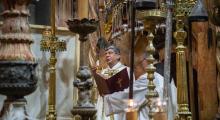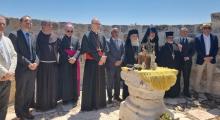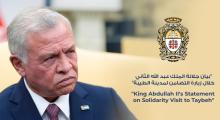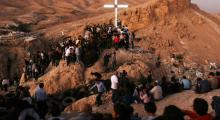Issued by the Catholic Center for Studies and Media - Jordan. Editor-in-chief Fr. Rif'at Bader - موقع أبونا abouna.org
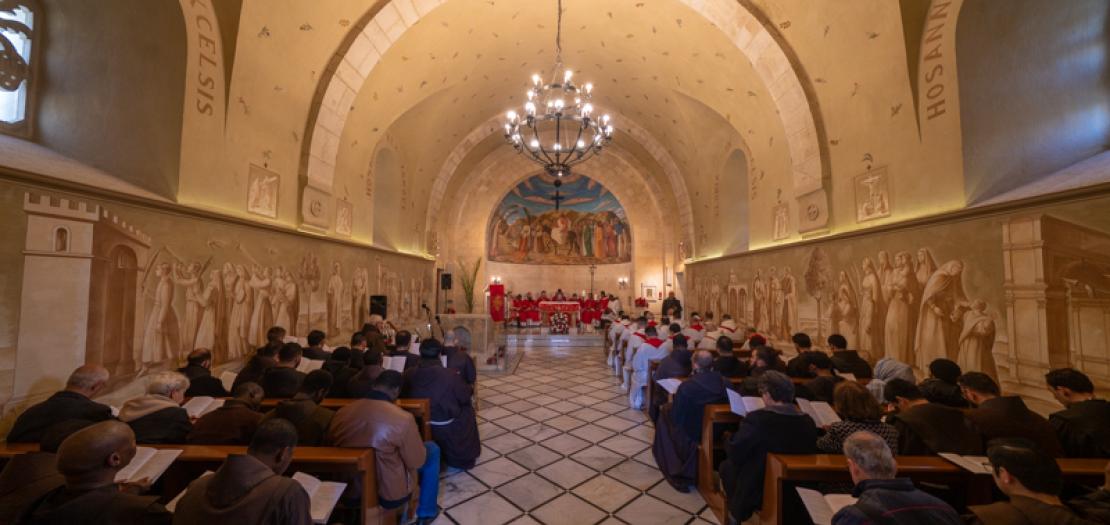
On April 1, 2023, the eve of Palm Sunday, as tradition has it, the last peregrination of the Franciscan friars took place in Bethphage, to commemorate the Lord’s entry into Jerusalem.
The memory of Jesus’ triumphant entry is located in this village on the eastern side of the Mount of Olives where, from as early as the 4th century, thanks to the pilgrim Egeria, there is news of the existence of a church which preserved the memory of the encounter between Jesus and the sisters of Lazarus, Martha and Mary, on the road for Bethania. Then, in the 9th century, Epiphanius the monk also noted that the procession to Jerusalem started “about one mile (from the Ascension),” where Christ sat on the colt.
The exact memory of the place had been lost until, in 1879, a cubic-shaped rock was found – now incorporated into the present-day church –, of which the still visible outer paintings, from the times of the Crusaders, recall the events linked to the entry of Jesus into the Holy City: Martha, Mary and Lazarus resuscitated, a crowd holding palm fronds and a donkey and its colt loosened from their ties before the eyes of the villagers. Then, in 1883 the Franciscans acquired this property and built first a small sanctuary and then, in 1954, a church, restored in 2014.
Before many local Christians, friars and pilgrims, Father Cyryl Kowalczyk, lecturer in the Holy Scripture at the Pontifical Antonianum University, presided the Holy Mass of the Sanctuary, preceded by the singing of the Psalms of the morning lauds. The Gospel proclaimed was that of the entry of Jesus into Jerusalem. The meditation was entrusted, as during every peregrination of this Lent, to Fr. Alessandro Coniglio, lecturer and secretary of the Studium Biblicum Franciscanum, who has guided the friars and the faithful in understanding the readings of the day.
“A key to better understand how Jesus makes the Old Testament expectations come true,” Fr. Alessandro Coniglio explained in his homily, “comes to us from the cries of the crowd on that Palm Sunday: “Blessed he who comes, the king, in the name of the Lord. Peace in heaven and glory in the highest of heavens!” Jesus was acclaimed king and the expectation is that celestial peace finally comes with him! But the crowd acclaims Jesus as the King Messiah, quoting Psalm 118, in which God is praised because his love is eternal, and because he is the help and salvation of those who invoke him.
Fr. Coniglio underlines how Psalm 118 perfectly describes the dynamics of rejection that Jesus had to endure by the leaders of his people, “but,” the preacher continues, “he already announces to us his victory over death: Jesus is therefore the foundation stone, the cornerstone which, refused by the builders, will be used by God himself to build the marvellous work of the salvation, awaited by all peoples. This is the reversal of fate by God himself in relation to his servant. In these Lenten peregrinations the figure of the suffering servant of Isaiah, who undergoes passion and death, but to whom God has promised a sensational victory, has often accompanied us.”
On Sunday April 3, at 2:30pm., it is from here that the joyous procession commemorating the entry of Jesus into Jerusalem will start. Since 1933, this event has also been able to take place with maximum solemnity under the presidency of the Latin Patriarch of Jerusalem.




